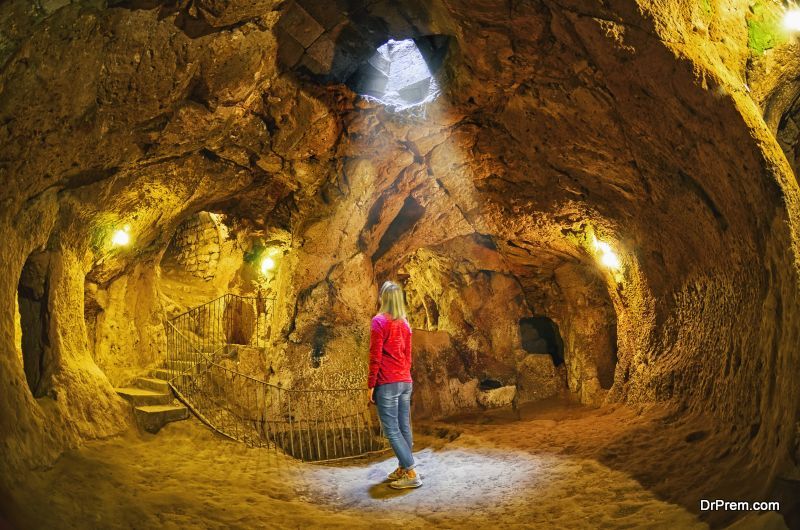My recent visit to Cappadocia in Turkey for attending a high-powered global conference on health and wellness was marked by pleasant surprises. Not only the country offers mesmerizing landscapes and an exquisite ancient civilization worth exploring, the underground cities built thousands of years ago are also great tourist pullers.
There are 36 underground cities running around different regions of Cappadocia that provided shelter for the locals during the war from external attacks and plunder. Among a number of cities, Kalymakli is the most famous one which I chose to explore.
To be specific Kaymakli, the city that runs throughout a basement sort of setting is secluded within the ancient fort of Kaymakli located in the central Anatolian plateau of Turkey. These caves were first exposed to tourists in the year 1964. This ancient settlement was roughly located at a distance of 19 kilometres from Nevsehir right along the Nevsehir – Nigade road.
History:
Originally known as Enegup Caverns, these caves were known to be constructed way back in the primitive era by the Phrygian tribesmen belonging to the Indo European culture using the molten volcanic rock. They had inhabited this region in the 8th to 7th Century BC so far as information from the Turkish ministry of History and culture could feed us back.
Eventually, the Phrygian language was lost in oblivion and was replaced by the ancient Greek and Roman dialects. Later, the Christians had carried out their own masonry works extended inside these ancient caves and Churches with exquisite artwork were built.
This underground city was inhabited in the Byzantine period. It was used as a protective citadel against the Muslim Arabs when tumultuous battles broke out between the Christians and Muslims in the Arab – Byzantine war that spanned between 780 – 1180 BC.
Following the Mongol invasion, the city was captured by the Ottoman Turks. The city was used as a shelter by the locals to escape the oppression of Turkish Muslim rulers also known as the Cappadocian Greeks.
This city was linked up to the Derinkuyu underground city (the deepest one) by a web of tunnels that ran for miles. The antiques and remains of ancient civilizations over here could be traced back to the Mid Byzantine era spanning between 5th and 10th centuries AD.
Way back in 1923, the Christian settlers in this historically dramatic terrain were driven out and the free flowing interaction between the Turks and the Greeks came to an end. The tunnels were deserted and shut down from use.
My expedition:
The entire milieu was immensely hypnotic. Every of bit of information enriched with antiquity got deeply registered in my mind and every sight of the ancient workmanship left me dumbfounded with waves of surprises. The scenes laden with history gradually unfolded delivering loads of exotic appeal as I progressed through the cavernous environment.
Thanks to the guide for his extensive knowledge and the pains he took in demonstrating every detail the ruins offered. Hiring a guide is compulsory if you wish to explore the underground city to the fullest. Not only does he go on feeding with important information but would also save you from getting lost amidst the twists and turns of the tunnel.
There are close to a hundred tunnels that formed a spectacular maze and the entire rural settlement of this underground city was constructed around these exotic tunnels. This city used to house about 5000 people during the war and when peace ruled, people got engaged in storing food and restructuring it for future use.
The tunnels constructed thousands of years back are quite narrow allowing very little elbow room. But I would praise the Tourism ministry and Turkish government who had done a praiseworthy job in providing enough lighting and direction signs in the tunnels that somehow eased the movement of tourists. Moreover, to hold the attraction of tourists, the government left no stone unturned in protecting this historic construction from natural erosion.
This sort of tunnel expedition may not be comfortable for the claustrophobics but enough ventilation in the tunnels allowed me a comfortable underground tour. I learned that not even a single case of accident had been reported ever!
Though located underground, the entire city provided habitable conditions for a society to run without much problem. Leading life underground is not easy, but I was surprised to see the smart arrangements that helped thousands of people survive in the adverse conditions. Perhaps, it is the natural adaptation quality of human beings that helps!
From the guide, I could collect that the various floors of the city were allocated to different sections of people. For example, the first floor used to be the stable housing animals, the second floor that housed a church was meant for the priests, the third floor was for the middle and upper class people and the fourth one for the poor and lower class.
I could spot the living rooms, bedrooms, wine cellar and storage areas that provided some comfort in times of distress. Even the city had burial grounds! The names inscribed on the graves are still readable in spite of withstanding continuous erosion. It reveals that people used to dwell for a considerable long time underground remaining undetected from the evil eyes of the enemy.
Priests were held in high esteem in the society and special areas were allocated to them to conduct prayers and meetings. In case of any impending danger, the priests and other respected members of the society were provided the escape route to another underground city through the interconnected tunnels.
The construction of this huge network of tunnels bears a testimony to the architectural expertise of the people belonging to that era. The stone doors were intelligently placed which could be shut when required. Proper construction of window shafts provided the required ventilation that allowed in the required oxygen supply.
It may strike your mind that how people can dwell with families amidst such space restrictions. But I was marveled viewing the massive kitchens, spacious resting places and cradle areas for kids which answered many of my questions. The guide further informed me that cooking used to be carried out at night so that the smell of food or the light of fire did not catch the enemy’s attention.
Surely, such a well planned construction did not come up overnight. Years of experience in fighting extreme adverse conditions drove people towards reconstruction of the city that was a never ending process till the necessity to hide underground ended. My underground expedition of Cappadocia has been fed with exciting experiences. It was rich, educative and an eye-opener that would remain etched in my mind forever.


